LG Electronics USA S159FZ Microwave Oven User Manual EMISSION TEST REPORT
LG Electronics USA Microwave Oven EMISSION TEST REPORT
Contents
- 1. Users Manual
- 2. User Manual
User Manual

Order Number
: GETEC-C1-17-153
FCC Part 18
Test Report Number
: GETEC-E3-17-010
Page 1 / 1
EUT Type: Microwave Oven
FCC ID: BEJS159FZ
APPENDIX G
: USER’S MANUAL

MFL69850402_00
OWNER’S MANUAL
MICROWAVE
OVEN
Read this owner’s manual thoroughly before operating the appliance
and keep it handy for reference at all times.
www.lg.com
LMC1575**
Copyright © 2017 LG Electronics Inc. All Rights Reserved.

PRECAUTIONS TO AVOID POSSIBLE
EXPOSURE TO EXCESSIVE
MICROWAVE ENERGY...
•Do not attempt to operate this oven
with the door open since open-door
operation can result in harmful exposure
to microwave energy. It is important
not to defeat or tamper with the safety
interlocks.
•Do not place any object between the
oven front face and the door or allow
soil or cleaner residue to accumulate on
sealing surfaces.
•Do not operate the oven if it is
damaged.
It is particularly important that the oven
door closes properly and that there is no
damage to the:
(1) door (bent),
(2) hinges and latches (broken or
loosened),
(3) door seals and sealing surfaces.
•The oven should not be adjusted or
repaired by anyone except properly
qualified service personnel.
Thank you for purchasing an LG microwave oven.
Please record the model number and serial number
of this unit for future reference. We also suggest
you record the details of your contact with LG
Electronics U.S.A., Inc. concerning this unit.
Staple your receipt here for proof of purchase.
Model No:
Serial No:
Dealer:
Dealer Phone No:
Customer Relations
LG Electronics U.S.A., Inc.
Service Division Bldg. #3
201 James Record Rd.
Huntsville, AL 35824-0126

3
TABLE OF CONTENTS
TABLE OF CONTENTS
4 IMPORTANT SAFETY
INSTRUCTIONS
8 PRODUCT OVERVIEW
8 Location of Model Number
8 Electrical Requirements
8 Voltage Warning
8 Placement of the Oven
8 Do Not Block Air Vents
8 Grounding Instructions
9 Radio / TV / Wireless Equipment Interference
9 Oven Specifications
10 Microwave Oven Features
10 Accessories
11 Control Panel Overview
12 MICROWAVE COOKING TIPS
12 Microwave Cookware Guide
13 Microwave-Safe Cookware
14 Microwave Cooking Tips
15 Precautions
16 OPERATION
16 Audible Signals
16 Clock
16 Interrupting Cooking
16 Child Lock
17 Kitchen Timer
17 Slide Touch Key
18 Correctly Using Slide Touch Key
18 If Slide Touch Key Doesn't Respond
18 Quick Start
18 More / Less
18 Energy Saving
19 Setting Manual Cooking Times
19 Microwave Power Levels
20 Sensor Operation Instructions
20 Sensor Cooking Guide
20 Sensor Cook
20 Sensor Reheat
20 Sensor Popcorn
21 Sensor Cook Table
22 Sensor Reheat Table
22 Popcorn Table
23 Defrost
23 Defrost Table
24 Defrosting Tips
24 Weight Conversion Table
24 Operating Tips
25 SMART DIAGNOSIS™
25 Using the Smart Diagnosis™ Function
26 MAINTENANCE
26 Caring for the Microwave Oven
27 TROUBLESHOOTING
27 Frequently Asked Questions
28 Before Calling for Service
29 WARRANTY

4IMPORTANT SAFETY INSTRUCTIONS
IMPORTANT SAFETY INSTRUCTIONS
Read and follow all instructions when using the microwave oven to prevent the risk of fire,
electric shock, personal injury, or damage. This guide does not cover all possible conditions
that may occur. Always contact your service agent or manufacturer about problems that you
do not understand.
Download this owner's manual at: http://www.lg.com
This is the safety alert symbol. This symbol alerts you to potential hazards that
can result in property damage and/or serious bodily harm or death.
All safety messages will follow the safety alert symbol and either the word
WARNING or CAUTION. These words mean:
WARNING - Indicates a hazardous situation which, if not avoided, could result
in death or serious injury.
CAUTION - Indicates a hazardous situation which, if not avoided, could result
in minor or moderate injury.
The safety instructions below will tell you how to use your oven and avoid harm to yourself
or damage to your oven.
WARNING
•To reduce the risk of burns, electric shock, fire, injury to persons or exposure to
excessive microwave energy when using the microwave oven, follow basic safety
precautions, including the following.
•Read all the instructions before using the oven.
•As with any appliance, close supervision is necessary when used by children.
•Read and follow the specific PRECAUTIONS TO AVOID POSSIBLE EXPOSURE TO
EXCESSIVE MICROWAVE ENERGY found on page 2.
•Use this appliance only for its intended use as described in the manual.
Do not use corrosive chemicals or vapors, such as sulfide and chloride, in this
appliance. This type of oven is specifically designed to heat, cook, or dry food. It is not
designed for industrial or laboratory use.
•Do not store this appliance outdoors. Do not use this product near water - for example,
near a kitchen sink, in a wet basement, near a swimming pool, or similar location.
•Do not use this oven for commercial purposes. It is made for household use only.
•When cleaning surfaces of door and oven that come together on closing the
door, use only mild, nonabrasive soaps, or detergents applied with a sponge or
soft cloth.
•If your oven is dropped or damaged, have it thoroughly checked by a qualified
service technician before using it again.

5
IMPORTANT SAFETY INSTRUCTIONS
WARNING
•To reduce the risk of fire in the oven cavity:
- Do not overcook food. Carefully attend to the microwave oven when paper, plastic
or other combustible materials are placed inside the oven to facilitate cooking.
- Do not use the cavity for storage purposes.
Do not leave paper products, cooking utensils or food in the cavity when not in use.
- Remove wire twist-ties from paper or plastic bags before placing bags in oven.
•If materials inside the oven ignite:
- Keep oven door closed
- Turn the oven off
- Disconnect the power cord or shut off power at the fuse or circuit breaker
panel.
•To avoid electric shock:
- This appliance must be grounded. Connect only to a properly grounded outlet. See
the electrical GROUNDING INSTRUCTIONS on page 8.
- Do not operate this appliance if it has a damaged cord or plug, if it is not working
properly or if it has been damaged or dropped.
- Do not immerse the electrical cord or plug in water.
- Keep cord away from heated surfaces.
- Do not let cord hang over edge of table or counter.
•Take care when the door is opened to avoid injury.
•To avoid improperly cooking some foods:
- Do not heat any type of baby bottle or baby food. Uneven heating may occur and
possibly cause personal injury.
- Do not heat small-necked containers, such as syrup bottles.
- Do not deep-fat fry in the microwave oven.
- Do not attempt home canning in the microwave oven.
- Some products such as whole eggs and sealed containers – for example,
closed glass jars – are able to explode and should not be heated in this oven.
•Do not cover or block any openings on the appliance.
•Do not run the oven empty.
•Install or locate this appliance only in accordance with the provided installation
instructions.
•This appliance should be serviced only by qualified service personnel. Contact the
nearest authorized service facility for examination, repair, or adjustment.
•Liquids, such as water, coffee, or tea can be overheated beyond the boiling point
without appearing to be boiling due to surface tension of the liquid. Visible bubbling or
boiling when the container is removed from the microwave oven is not always present.
THIS COULD RESULT IN VERY HOT LIQUIDS SUDDENLY BOILING OVER WHEN
THE CONTAINER IS DISTURBED OR A SPOON OR OTHER UTENSIL IS INSERTED
INTO THE LIQUID.
•To reduce the risk of injury to persons;
- Do not overheat the liquid.
- Stir the liquid both before and halfway through heating it.
- Do not use straight-sided containers with narrow necks.
- After heating, allow the container to stand in the microwave oven for a short time
before removing the container.
- Use extreme care when inserting a spoon or other utensil into the container.

6IMPORTANT SAFETY INSTRUCTIONS
•Do not use the oven for the purpose of dehumidification (for example, operating the
microwave oven with wet newspapers, clothes, toys, electric devices, plants, soil, pets
or any other living matter inside it). The oven must only be used for heating or cooking
food.
- The results of misuse can include safety risks such as fire, burns, or death due to
electric shock.
•This appliance is not intended for use by persons (Including children) with reduced
physical, sensory or mental capabilities, or lack of experience and knowledge, unless
they have been given supervision or instruction concerning use of the appliance by a
person responsible for their safety. Children should be supervised to ensure that they
do not play with the appliance.
- Improper use may cause damage such as a fire, electric shock or burn.
•Accessible parts may become hot during use. Young children should be kept away.
- They may be burned.
•Children must not be allowed to play with accessories or hang down from the door or
any part of the oven.
- Doing so can cause serious injury and damage.
•If the door or door seals are damaged, the oven must not be operated until it has been
repaired by a competent person.
•The appliance and its accessible parts become hot during use. Care should be taken
to avoid touching heating elements. Children shall be kept away unless continuously
supervised.
•During use the appliance becomes hot. Care should be taken to avoid touching heating
elements inside the oven.
•Do not use recycled paper products.
- They may contain impurities which may cause sparks and/or fires when used in
cooking.
•Do not rinse trays and racks by placing them in water just after cooking. This may
cause breakage or damage.
- Improper use could result in damage to the oven.
•The oven should be cleaned regularly and any food deposits should be removed.
- Failure to maintain the oven in a clean condition could lead to deterioration of the
surface that could adversely affect the life of the appliance and possibly result in a
hazardous situation.
•The door or the outer surface may get hot when the appliance is operating.
•Liquids heated in certain shaped containers (especially cylindrical-shaped containers)
may become overheated. The liquid may splash out with a loud noise during or after
heating or when adding ingredients (instant coffee. etc.), resulting in harm to the oven
and possible injury. In all containers, for best results, stir the liquid several times before
heating. Always stir liquid several times between reheatings.
WARNING

7
IMPORTANT SAFETY INSTRUCTIONS
FEDERAL COMMUNICATIONS COMMISSION RADIO FREQUENCY
INTERFERENCE STATEMENT (U.S.A. ONLY)
This equipment generates and uses ISM frequency energy and if not installed and used
properly, that is in strict accordance with the manufacturer's instructions, may cause
interference to radio and television reception. It has been type tested and found to comply
with limits for ISM Equipment pursuant to part 18 of FCC Rules, which are designed to
provide reasonable protection against such interference in a residential installation.
However, there is no guarantee that interference will not occur in a particular installation.
If this equipment does cause interference to radio or television reception, which can be
determined by turning the equipment off and on, the user is encouraged to try to correct the
interference by one or more of the following:
•Reorient the receiving antenna of the radio or television.
•Relocate the Microwave Oven with respect to the receiver.
•Move the microwave oven away from the receiver.
•Plug the microwave oven into a different outlet so that the microwave oven and the
receiver are on different branch circuits.
The manufacturer is not responsible for any radio or TV interference caused by unauthorized
modification to this microwave oven. It is the responsibility of the user to correct such
interference.
WARNING
This product contains chemicals known to the State of California to cause cancer and
birth defects or other reproductive harm. Wash hands after handling.
Read all instructions before using the appliance.
SAVE THESE INSTRUCTIONS
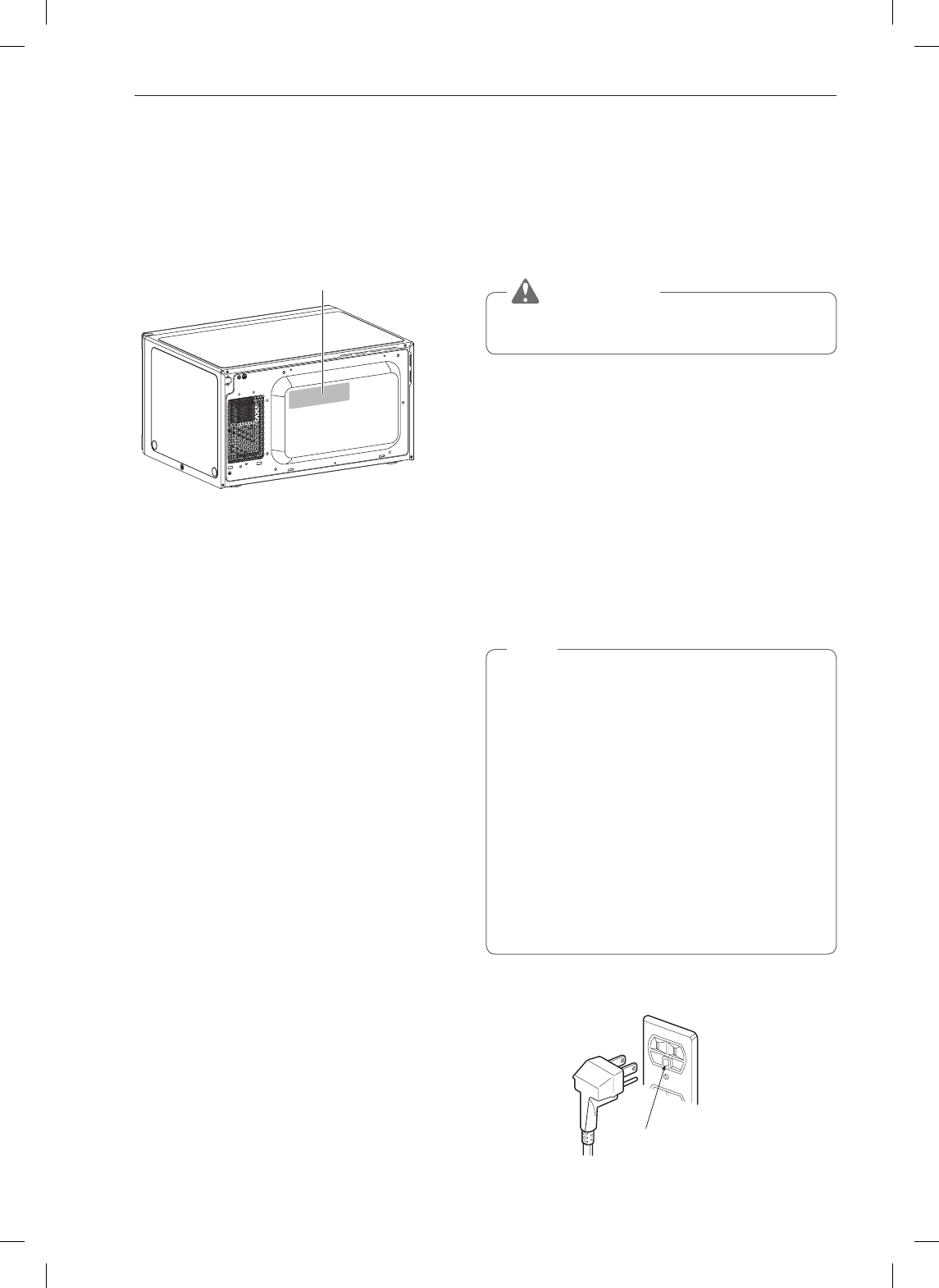
8PRODUCT OVERVIEW
PRODUCT OVERVIEW
Location of Model Number
To request service information or replacement parts,
the service center requires the complete model
number of your microwave oven. The model number
is on the oven back as shown in the illustration below.
Model number label
Electrical Requirements
The oven is designed to operate on a Standard 120
V/60 Hz household outlet. Be sure the circuit is at
least 15 A or 20 A and the microwave oven is the only
appliance on the circuit. It is not designed for 50 Hz
or any circuit other than a 120 V/60 Hz circuit.
No other electrical appliances or lighting circuits
should be on this line. If in doubt, consult a licensed
electrician.
Voltage Warning
The voltage used at the wall receptacle must be the
same as specified on the oven name plate located
on the back or on the side of the control panel of the
oven. Use of a higher voltage is dangerous and may
result in a fire or other type of accident causing oven
damage. Low voltage will cause slow cooking. If the
microwave oven does not perform normally in spite of
proper voltage, remove and reinsert the plug.
Placement of the Oven
The microwave oven can be placed easily in your
kitchen, family room, or anywhere else in your home.
Place the oven on a flat surface such as a kitchen
countertop or a specially designed microwave oven
cart. Do not place oven above a gas or electric range.
Free airflow around the oven is important. Allow at
least 4 inches of space at the top, sides, and back of
the oven for proper ventilation.
Do Not Block Air Vents
All air vents should be kept clear during cooking. If
air vents are covered during oven operation the oven
may overheat. If this happens, a sensitive thermal
safety device automatically turns the oven off. The
oven will be inoperable until it has cooled sufficiently.
Grounding Instructions
This appliance must be grounded. In the event of
an electrical short circuit, grounding reduces the
risk of electric shock by providing an escape wire
for the electric current. This appliance is equipped
with a cord having a grounding wire with a grounding
plug. The plug must be plugged into an outlet that is
properly installed and grounded.
WARNING
•Improper use of grounding can result in a
risk of electric shock.
Consult a qualified electrician or service person if the
grounding instructions are not completely understood,
or if doubt exists as to whether the appliance is
properly grounded.
1. Use of an extension cord is not recommended. If
the power supply cord is too short, have a qualified
electrician or service person install an outlet near
the appliance.
2. If it is necessary to use an extension cord, use
only a 3-wire extension cord that has a 3-blade
grounding plug, and a 3-slot receptacle that will
accept the plug on the appliance. The marked rating
of the extension cord must be equal to or greater
than the electrical rating of the appliance.
NOTE
•A short power supply cord is provided to reduce
the risks resulting from becoming entangled in
or tripping over a longer cord.
•Longer cord sets or extension cords are
available and may be used if care is exercised
in their use.
•If a long cord or extension cord is used, (1)
the marked electrical rating of the cord set or
extension cord must be at least as great as
the electrical rating of the appliance, (2) the
extension cord must be a grounding-type 3-wire
cord, and (3) the longer cord should not be
draped over a counter or table where children
could pull on it, or located where it could
present a trip hazard.
See the separate Installation Instructions for
directions on placing the cord properly.
Ensure proper ground
exists before use
Keep the electrical power cord dry and do not pinch
or crush it in any way.

9
PRODUCT OVERVIEW
Radio / TV / Wireless Equipment Interference
Operating the microwave oven near equipment—such as a radio, TV, wireless LAN, Bluetooth devices, medical
equipment, or wireless equipment—which uses the same frequency, may cause interference. This interference
is not an indication of a defect in the product or its operation. The product is safe to use.
WARNING
•Do not use medical equipment near the microwave oven, as the interference could affect the medical
equipment’s operation.
When there is interference, it may be reduced or eliminated by taking the following measures:
a. Clean the door and the sealing surfaces of the oven.
b. Reorient the receiving antenna of the radio, TV, Bluetooth, or other equipment.
c. Relocate the microwave oven in relation to the radio, TV, Bluetooth, or other equipment.
d. Move the microwave oven away from the receiver.
e. Plug the microwave oven into a different outlet so that microwave oven and receiver are on different branch
circuits.
Oven Specifications
Model LMC1575**
Power Supply 120 V AC, 60 Hz
Rated Power Consumption 1250 W
Microwave Output Max. 1200 W*
Frequency 2450 MHz
Rated Current 10.4 A
Overall Dimensions (W x H x D) 21 7/16" x 12 1/8" x 17"
(54.4 cm x 30.8 cm x 43.2 cm)
Oven Cavity Dimensions (W x H x D) 15 9/16" x 10 5/16" x 16"
(39.5 cm x 26.2 cm x 40.6 cm)
Capacity of Oven Cavity 1.5 cu.ft (0.04 m³)
* IEC 60705 RATING STANDARD
Specifications subject to change without prior notice.
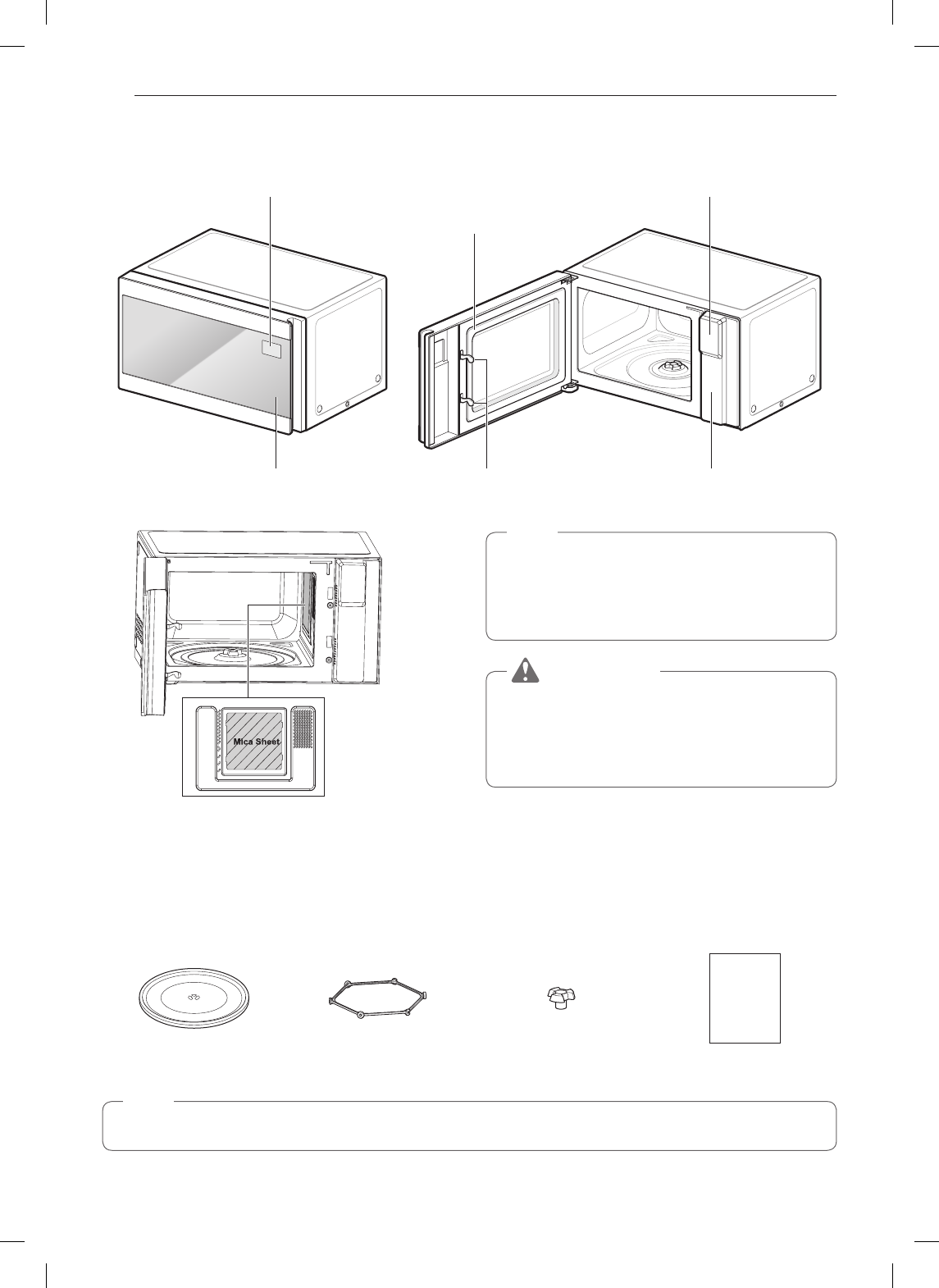
10 PRODUCT OVERVIEW
Microwave Oven Features
Door Seal
Display WindowDisplay Window
Control PanelSafety Door Lock SystemControl Panel
* Do Not Remove
Mica Sheet
NOTE
•Do not remove the cavity Mica Sheet (silver
plate) inside of oven.
•The Mica Sheet is there to protect the
microwave components from food spatters.
WARNING
•Do not operate the oven when empty or without
the glass tray. It is best to leave a glass of
water in the oven when not in use. The water
will safely absorb all microwave energy, if the
oven is accidentally started.
Accessories
The turntable rotates in both directions to help food cook more evenly. Do not operate the microwave oven
without the glass tray in place.
Owner's
Manual
Glass Tray Rotating Ring Shaft Owner's Manual
NOTE
This microwave oven is designed for household use only. It is not recommended for commercial use.
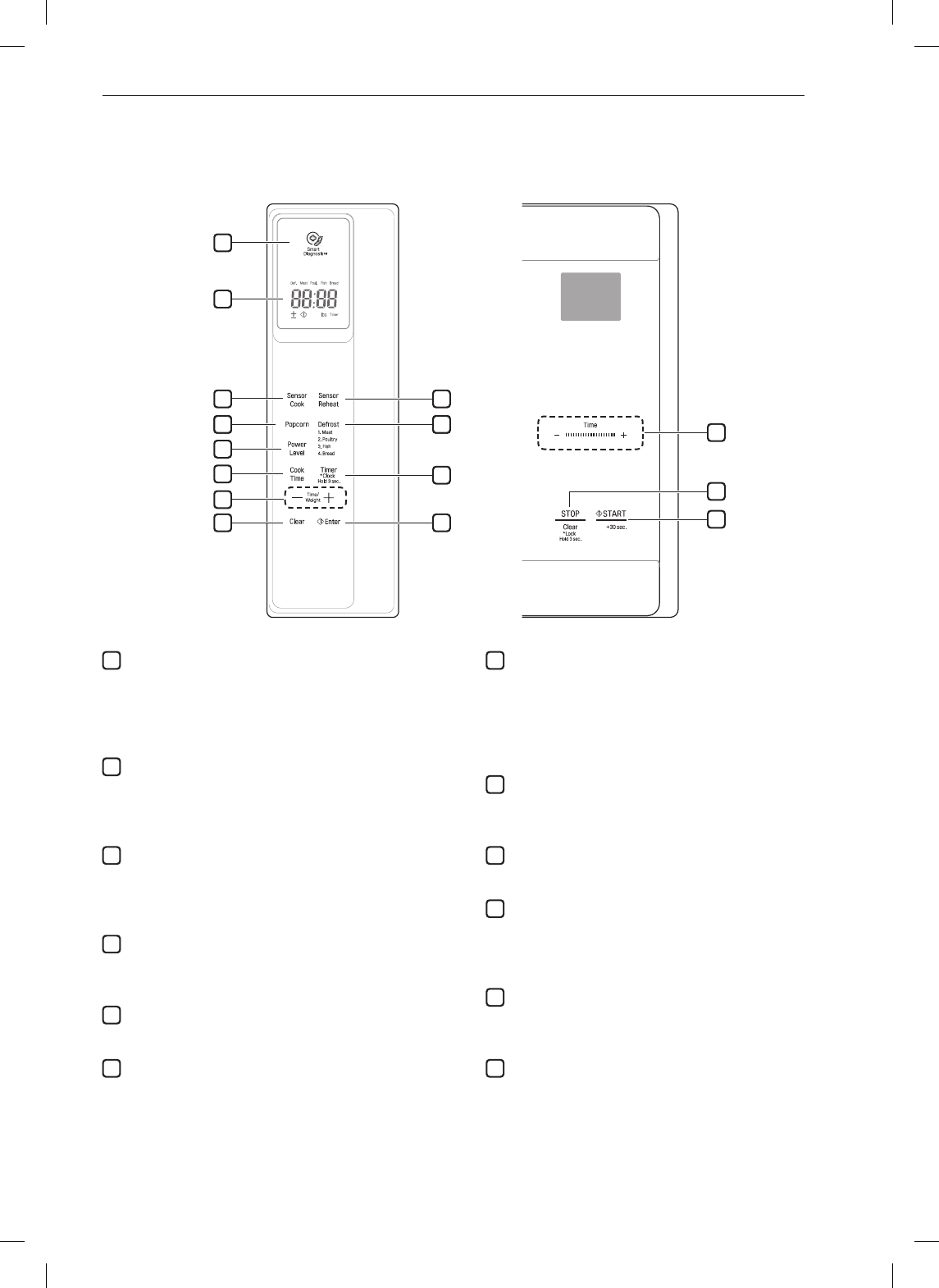
11
PRODUCT OVERVIEW
Control Panel Overview
Use the control panel to select the desired cooking function quickly and easily. Simply touch a command key to
select the desired function. For more information on these features, see the OPERATION section.
4
10
12
11
9
12
66
1
2
3
8
11
10
55
7
1
Smart Diagnosis
Hold the mouthpiece of a phone up to this icon
when directed to by service center personnel,
to help diagnose problems with the oven when
calling for service.
2
Display
The display includes a clock and shows the
time of day, cooking time settings, and cooking
functions selected.
3
Sensor Cook
Touch this key to cook bacon, fresh vegetables,
frozen entrees, frozen vegetables, oatmeal,
potatoes, and rice.
4
Sensor Reheat
Touch this key to reheat beverages, casseroles,
dinner plates, pie, and pizza.
5
Sensor Popcorn
Touch this key to pop popcorn.
6
Defrost
Touch this key to select food type and defrost food
by weight.
7
Power Level
The microwave oven is equipped with 10 power
levels for maximum flexibility and control over
cooking. The Microwave Power Levels section
contains suggestions for which power level to use
when preparing various foods.
8
Cook Time
Touch this key to manually set a desired cook
time.
9
Timer On/Off
Touch this key to set a kitchen timer.
10
More / Less
Set cooking time and weight. Lengthen or shorten
the cooking time at any point by pressing the key.
(Not available in Defrost mode.)
11
STOP / Clear
Touch this key to stop the oven or to clear all
entries except time of day.
12
START / Enter
Touch this key to start a function, accept
selections, or resume cooking if the door was
opened or the STOP button was pressed once.
Pressing START without setting a cook time
activates the Quick Start feature. Each press of the
START button adds 30 seconds to the cooking time.

12 MICROWAVE COOKING TIPS
MICROWAVE COOKING TIPS
Microwave Cookware Guide
Use Do Not Use
OVENPROOF GLASS
(treated for high intensity heat):
utility dishes, loaf dishes, pie plates, cake
plates, liquid measuring cups, casseroles
and bowls without metallic trim.
CHINA:
bowls, cups, serving plates, and platters
without metallic trim.
PLASTIC:
Plastic wrap (as a cover)- lay the plastic
wrap loosely over the dish and press it to
the sides.
Vent plastic wrap by turning back one edge
slightly to allow excess steam to escape.
The dish should be deep enough so that
the plastic wrap will not touch the food. As
the food heats it may melt the plastic wrap
wherever the wrap touches the food.
Use plastic dishes, cups, semi-rigid freezer
containers and plastic bags only for
short cooking time. Use these with care
because the plastic may soften from
the heat of the food.
PAPER:
Paper towels, waxed paper, paper
napkins, and paper plates with no metallic
trim or design. Look for the manufacturer's
label for use in the microwave oven.
Note:
Do not use recycled paper products in the
microwave oven. They sometimes contain
impurities that cause arcing and sparking.
METAL CONTAINERS:
Metal shields the food from microwave energy and produces
uneven cooking. Also avoid metal skewers, thermometers, or
foil trays. Metal containers can cause arcing, which can damage
the microwave oven.
METAL DECORATION:
Metal-trimmed or metal-banded dinnerware, casserole dishes,
etc. The metal trim interferes with normal cooking and may
damage the oven.
ALUMINUM FOIL:
Avoid large sheets of aluminum foil because they hinder
cooking and may cause harmful arcing. Use small pieces of
foil to shield poultry legs and wings. Keep ALL aluminum foil at
least 1 inch from the side walls and door of the oven.
WOOD:
Wooden bowls and boards will dry out and may split or crack
when you use them in the microwave oven. Baskets react in the
same way.
TIGHTLY COVERED COOKWARE:
Be sure to leave openings for steam to escape from covered
containers. Pierce plastic pouches of vegetables or other food
items before cooking. Tightly closed pouches could explode.
BROWN PAPER:
Avoid using brown paper bags.
They absorb too much heat and could burn.
FLAWED OR CHIPPED UTENSILS:
Any container that is cracked, flawed, or chipped may break in
the oven.
METAL TWIST TIES:
Remove metal twist ties from plastic or paper bags.
They become hot and could cause a fire.

13
MICROWAVE COOKING TIPS
Microwave-Safe Cookware
Never use metal or metal trimmed cookware
when using microwave function
Microwaves cannot penetrate metal. They will bounce
off any metal object in the oven and cause arcing, an
alarming phenomenon that resembles lightning. Most
heat resistant non-metallic cookware is safe for use
in your oven. However, some may contain materials
that render it unsuitable as microwave cookware. If
you have any doubts about a particular container,
there's a simple way to find out if it can be used in the
microwave.
Testing Cookware before Use
Place the container in question next to a glass bowl
filled with water inside the oven. Microwave at HIGH
power for 1 minute. If the water heats up but the
container remains cool to the touch, the container is
microwave-safe.
However, if the water does not change temperature
but the container becomes warm, microwaves are
being absorbed by the container and it is not safe
for use in the microwave oven. See the following list
for tips on using common items when microwave
cooking.
Tableware
Many dishes are microwave-safe. If in doubt consult
the manufacturer's literature or perform the microwave
test. Do not put plates with painted decoration in
the oven, as the paint may contain metal and cause
arcing.
Glassware
Glassware that is heat-resistant is microwave-safe.
This includes all brands of oven tempered glass
cookware.
Do not use delicate glassware, such as tumblers or
wine glasses, as these might shatter as when heated.
Plastic Storage Containers
Use these only for quick reheating of food. Do not use
them when cooking food for long periods or at high
power levels, as the hot food will eventually warp or
melt the plastic.
Paper
Paper plates and containers are convenient and
safe to use in the microwave oven, provided that the
cooking time is short and foods to be cooked are low
in fat and moisture. Paper towels are also very useful
for wrapping foods and for lining baking trays in which
greasy foods such as bacon are cooked. In general,
avoid colored paper products as the color may run.
Some recycled paper products may contain impurities
which could cause arcing or fires when used in the
microwave.
Plastic Cooking Bags
Provided they are made specially for cooking, cooking
bags are microwave safe. Remember to make a
slit in the bag so that steam can escape. Never use
ordinary plastic bags for cooking in the microwave
oven, as they will melt and rupture.
Plastic Microwave Cookware
A variety of shapes and sizes of microwave cookware
are available. You may be able to use items you
already have on hand rather than investing in new
kitchen equipment.
Pottery, Stoneware, and Ceramic
Many containers made of these materials are
microwave-safe, but test them before use.
CAUTION
•Some items with high lead or iron content are
not suitable for microwave cooking.
•Cookware should be checked to ensure that it
is suitable for use in the microwave.

14 MICROWAVE COOKING TIPS
Microwave Cooking Tips
Keeping an Eye on Things
Always watch your food while it cooks. The light inside
the microwave oven turns on automatically when
the oven is cooking so you can monitor the cooking
process. Directions given in recipes to elevate, stir,
and the like should be thought of as the minimum
steps recommended. If the food seems to be cooking
unevenly, simply make the necessary adjustments
you think appropriate to correct the problem.
Factors Affecting Microwave Cooking Times
Many factors affect cooking times. The temperature
of ingredients used in a recipe makes a big difference
in cooking times. For example, a cake made with
ice-cold butter, milk, and eggs will take considerably
longer to bake than one made with ingredients that
are at room temperature. Some recipes, particularly
those for bread, cake, and custards, recommend that
food be removed from the oven when they are slightly
undercooked.
This is not a mistake. When allowed to stand, usually
covered, these foods will continue to cook outside of
the oven as the heat trapped within the outer portions
of the food gradually travels inward. If the food is left
in the oven until it is cooked all the way through, the
outer portions will become overcooked or even burnt.
Practice will improve your ability to estimate both
cooking and standing times for various foods.
Density of Food
Light, porous food such as cakes and breads cook
more quickly than heavy, dense foods such as
roasts and casseroles. You must take care when
microwaving porous food so that the outer edges do
not become dry and brittle.
Height of Food
The upper portion of tall foods, particularly roasts, will
cook more quickly than the lower portion.
Therefore, it is wise to turn tall food several times
during cooking.
Moisture Content of Food
Because the heat generated from microwaves
causes moisture to evaporate, relatively dry food
such as roasts and some vegetables should either
be sprinkled with water prior to cooking or covered to
retain moisture.
Bone and Fat Content of Food
Bones conduct heat and fat cooks more quickly than
meat. Care must be taken when cooking bony or fatty
cuts of meat in order to prevent unevenly cooked or
overcooked meat.
Quantity of Food
The number of microwaves in your oven remains
constant regardless of how much food is being
cooked. Therefore, the more food you place in
the oven, the longer the required cooking time.
Remember to decrease cooking times by at least one
third when halving a recipe.
Shape of Food
Microwaves penetrate only about 3/4 of an inch (2
cm) into food. The interior portion of thick foods is
cooked as the heat generated on the outside travels
inward. Only the outer edge of food is cooked by
microwave energy; the rest is cooked by conduction.
The worst possible shape for a food that is to be
microwaved is a thick square.
The corners will burn long before the center is even
warm. Round thin foods and ring-shaped foods cook
most successfully in the microwave.
Covering
A cover traps heat and steam which causes food to
cook more quickly. Use a lid or microwave cling film
with a corner folded back to prevent splitting.
Covering with Parchment Paper
Parchment paper (not waxed paper) is microwave
safe. Because it makes a looser cover than a lid or
clingfilm, greaseproof paper allows the food to dry out
slightly.
Stirring
Stirring is one of the most important of all microwaving
techniques. In conventional cooking, food is stirred for
the purpose of blending. Microwaved food, however,
is stirred in order to spread and redistribute heat.
Always stir from the outside towards the centre as the
outside of the food heats first.
Placing Thicker Portions Facing Outward
Place thicker cuts or portions of meat, poultry, and
fish toward the outer edge of the baking dish so they
absorb the most microwave energy and the food
cooks more evenly.

15
MICROWAVE COOKING TIPS
Shielding
Strips of aluminium foil (which block microwaves)
can be placed over the corners or edges of square
and rectangular foods to prevent those portions from
overcooking. Never use too much foil and make sure
the foil is secured to the dish or it may cause arcing in
the oven especially if the foil passes too closely to the
walls of the oven during rotation.
Elevating
Thick or dense foods can be elevated so that
microwaves can be absorbed by the underside and
center of the foods.
Piercing
Foods enclosed in a shell, skin or membrane are
likely to burst in the oven unless they are pierced
prior to cooking. Such foods include yolks and whites
of eggs, clams, oysters, potatoes, and other whole
vegetables and fruits.
Testing if Cooked
Microwaves cook food quickly, so test food for
doneness frequently. Some foods are left in the
microwave until completely cooked, but most foods,
including meats and poultry, should be removed from
the oven while still slightly undercooked and allowed
to finish cooking during standing time. The internal
temperature of foods will rise between 5 °F (3 °C) and
15 °F (8 °C) during standing time.
Standing Time
Foods are often allowed to stand for 3 to 10 minutes
after being removed from the oven. Usually the foods
are covered during standing time to retain heat unless
they are supposed to be dry in texture. Standing
allows foods to finish cooking and also helps flavors
blend and develop.
Precautions
•Place the front surface of the door three inches or
more from the countertop edge to avoid accidental
tipping of the microwave oven during normal use.
•To program the oven, make sure you touch the
center of each pad firmly since the areas between
the pads will not activate the oven. A tone will
sound each time a pad is touched correctly. Don’t
touch several pads at once.
•Do not strike the control panel with silverware,
utensils, etc. Breakage may occur.
•Always use caution when taking cookware out
of the oven. Some dishes absorb heat from the
cooked food and may be hot. See Cookware Guide
earlier in this section for more information.
•Do not rinse containers by placing them in water
immediately after cooking. This may cause
breakage. Also, always allow the turntable to cool
before removing it from the oven.
•Never operate the oven when it is empty. Food
or water should always be in the oven during
operation to absorb the microwave energy.
•Do not use the oven to dry newspapers or clothes.
They may catch fire.
•Use thermometers that have been approved for
microwave oven cooking.
•The turntable must always be in place when you
operate the oven.
•Do not use your microwave oven to cook eggs in
the shell. Pressure can build up inside the shell,
causing it to burst.
•There are several precautions to follow when
microwaving popcorn:
−Do not pop popcorn, except in a microwave-safe
container or commercial packages designed for
microwave ovens.
−Never try to pop popcorn in a paper bag that is
not microwave-approved.
−Overcooking may result in smoke and fire.
−Do not repop unpopped kernels.
−Do not reuse popcorn bags.
−Listen while corn pops. Stop oven when popping
slows to 2-3 seconds between pops.
−Do not leave microwave unattended while
popping corn.
−Follow directions on bag.

16 OPERATION
OPERATION
This section introduces you to the basics you need
to know to operate the microwave oven. Please read
this information before using the oven.
CAUTION
To avoid risk of personal injury or property
damage, do not use stoneware, metal
cookware, or metal rimmed cookware in the
oven.
Audible Signals
Audible signals are available to guide you when
setting and using the oven:
•A tone will sound each time you touch a key.
•A melody signals the end of a Timer countdown.
•A melody signals the end of a cooking cycle.
Clock
When the oven is plugged in for the first time or when
power resumes after a power interruption, the clock
defaults to the 12-hour clock mode and 12H appears
in the display. You can set the time or switch to the
24-hour clock mode.
Setting the Clock Mode and Time of Day
1Open the oven door.
Press + repeatedly to toggle between the 24-
hour (24H) and 12-hour (12H) clock mode.
2Press ENTER to set the clock mode.
3To set the time of day, press + or – to select the
desired hour.
4Press ENTER to set the hour.
5Press + or – to select the desired minutes.
6Press ENTER to finish setting the time of day.
Interrupting Cooking
Stop the oven during a cycle by opening the door.
The oven stops heating and the fan stops, but the
light stays on. To restart cooking, close the door and
touch START.
To stop cooking and clear the remaining cook
time, open the door and touch Clear.
Child Lock
Use this safety feature to lock the control panel and
prevent the oven from being turned on when cleaning
the oven or to prevent children from unsupervised
use of the oven.
Locking the Oven
1Touch and hold STOP/Clear until Loc
appears in the display and a melody sounds.
(approximately 3 seconds)
Unlocking the Oven
1Touch and hold STOP/Clear until Loc
disappears and a melody sounds.
(approximately 3 seconds)
NOTE
•If set, the time of day reappears in the display
after 1 second.
•If the oven is locked, Loc appears in the display
when any key is touched.
•Unlock the oven to resume normal use.
NOTE
•Press and hold + or - to quickly increase or
decrease numbers.
•You can also shut the door and use the Slide
Touch key to set the hours and minutes.
•To reset the clock mode, you must unplug
and reconnect the power cord.
•If you don't want the time of day to appear in the
display, press the STOP/Clear button, after
plugging in the oven.
•To reset the time of day, press and hold Timer
until a flashing ± appears in the display.
CAUTION
To avoid risk of personal injury or property
damage, do not run oven while it is empty.
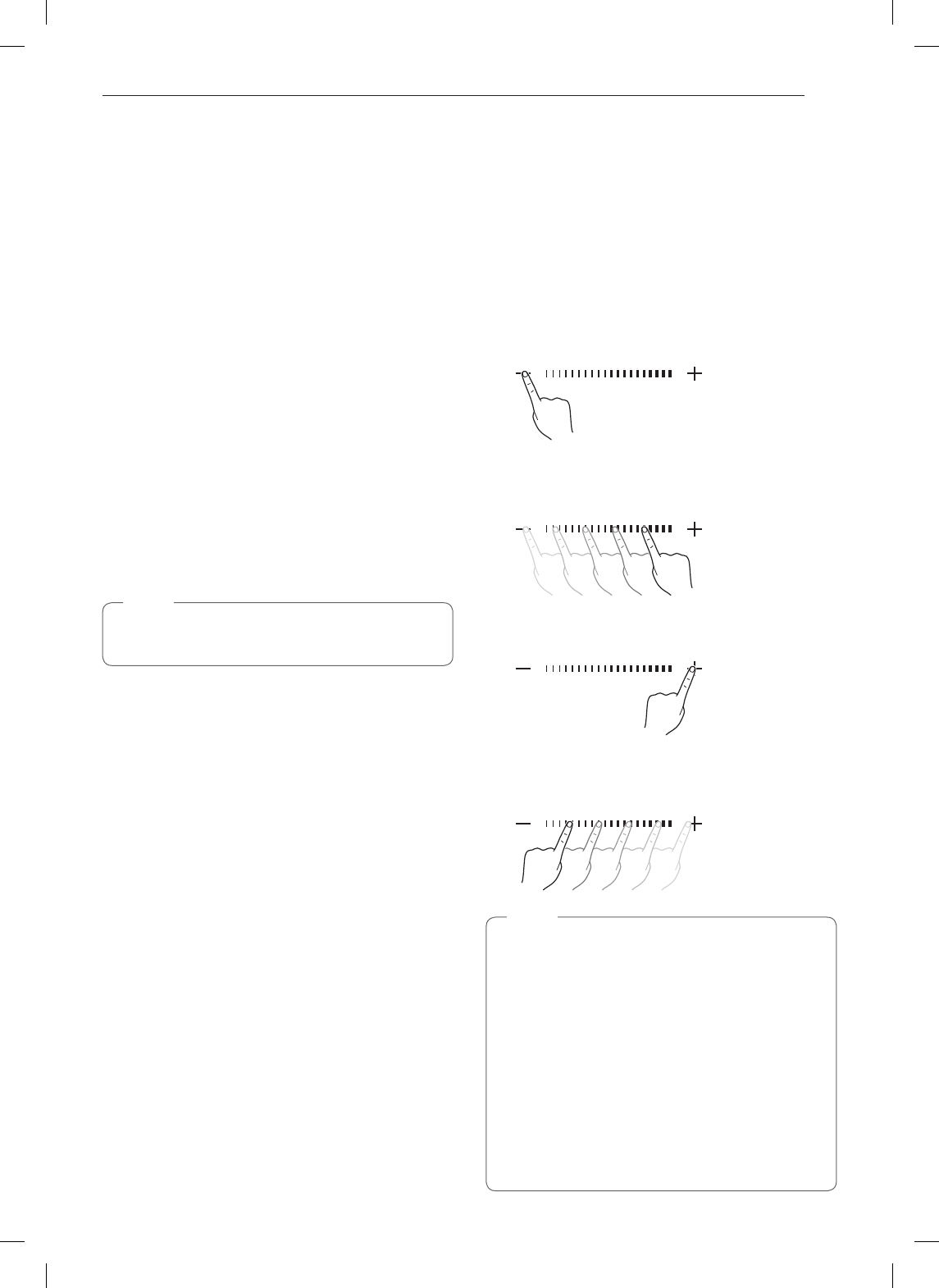
17
OPERATION
Kitchen Timer
The Timer function serves as an extra kitchen timer. It
chimes when the set time runs out. It does not start or
stop cooking.
Setting the Timer
1Open the oven door.
Press Clear.
2Press Timer once.
10 appears in the display.
3Set the desired time by pressing + or – until the
time appears in the display. (Press and hold + or
shut the oven door and use the Slide Touch key
to rapidly increase the time.)
4Press Enter to start the timer. The countdown
appears in the display.
Canceling the Timer
1Press Timer once.
The display returns to the time of day.
NOTE
•When the time is over a melody sounds and
End displays. Press Clear.
Slide Touch Key
Adjust numerical settings quickly using the Slide
Touch key on the outside of the oven door. The + and
– keys on either side of the Slide Touch key operate
exactly the same as the + and - keys on the inner
control panel and can also be used to quickly adjust
settings.
Increasing/Decreasing Numerical Settings
1Touching or pressing and holding the – button
will decrease the amount.
2To increase the amount, touch the end of the
slide bar nearest the – and slowly slide your
finger to the right.
3Touching or pressing and holding the + button
will increase the amount.
4To decrease the amount, touch the end of the
slide bar nearest the + and slowly slide your
finger to the left.
NOTE
•Numerical Increments:
−0~3 minutes : Time increases or decreases in
10-second increments.
−3~20 minutes : Time increases or decreases
in 30-second increments.
−20~90 minutes : Time increases or decreases
in 1-minute increments.
−While the microwave is cooking, the
remaining time increases or decreases in
10-second increments.
•Defrost weights are increased or decreased in
0.1-lb increments.
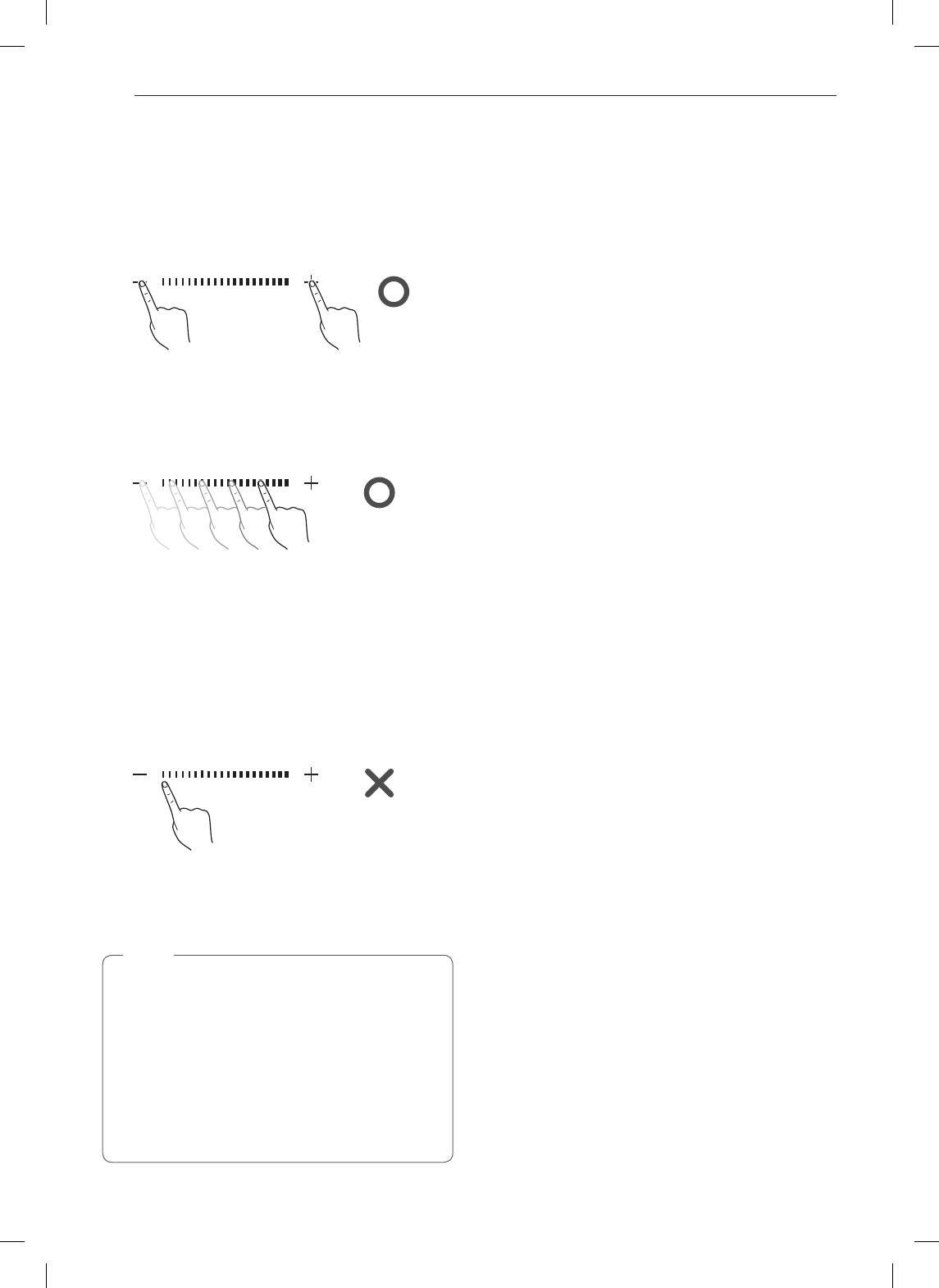
18 OPERATION
Correctly Using Slide Touch
Key
1Press the + or – keys repeatedly to adjust
numerical settings in individual increments.
Press and hold the keys to adjust numerical
settings quickly in the display.
Touch Touch
2Place your finger on the middle bar and swipe
right or left to increase or decrease numerical
settings quickly in the display. Don't forget to
press START to select the setting in the display.
If Slide Touch Key Doesn't
Respond
The Slide Touch Key may not respond to the
following:
1Touching outside of the sensor area for the key.
2Using a fingernail or thumb.
3Sliding a finger across the key too quickly.
NOTE
•Do not use a tool or device other than your
finger on the Slide Touch key. Do not wear
rubber or disposable gloves.
•After cleaning the touch control panel with a
wet towel, dry off any remaining moisture from
the touch control panel.
•If the numerical value in the display stops
changing while you are pressing the + or – key,
lift finger and try again.
Quick Start
The Quick Start feature allows you to set 30-second
intervals of High power cooking with each touch of
the START button.
1Close the oven door.
Press STOP/Clear.
2Press START.
•The oven will immediately start cooking for 30
seconds on high power.
•Press START repeatedly to extend the cook
time by 30 seconds every time the button is
pressed.
•The cook time can be extended to 99 minutes
and 59 seconds.
More / Less
By using the – or + key, manual cook settings can
be adjusted to cook food for a longer or shorter time.
Pressing + adds 10 seconds to the cooking time each
time you press it. Pressing – subtracts 10 seconds
from the cooking time each time you press it. The
maximum cooking time possible in the manual cook
mode is 99 min 59 seconds.
Adjusting the Cooking Time
1Close the oven door.
Press STOP/Clear.
2Press START.
3Press + or – to increase or decrease the
remaining time by 10 seconds.
Energy Saving
When the oven is not in use, the display turns off to
save energy, unless the time of day is set to show
in the display.

19
OPERATION
Setting Manual Cooking
Times
When not using the auto cooking functions, the
cooking time and power level are set manually.
2Press Cook Time once.
3Press + or – until the desired cooking time
appears in the display.
4Press Power Level once, P-HI appears in the
display.
•P-HI indicates that the power level is at 100%.
5Press – to decrease the power level in
10-percent increments, if desired.
6Close the oven door.
Press START.
•When cooking is complete, a chime sounds
and "End" appears in the display window.
"End" remains in the display and the chime
repeats every minute until the door is opened,
or any button is pressed.
NOTE
•If a power level is not selected, the oven
defaults to 100% power.
Microwave Power Levels
This microwave oven is equipped with 10 power
levels to give you maximum flexibility and control over
cooking. See the table for suggested power levels for
various foods.
Microwave Power Level Chart
Power
Level Use
P-HI
(100 %)
•Boiling water.
•Browning ground beef.
•Making candy.
•Cooking poultry pieces, fish, &
vegetables.
•Cooking tender cuts of meat.
P-90 •Reheating rice, pasta, & vegetables.
P-80 •Reheating prepared foods quickly.
•Reheating sandwiches.
P-70 •Cooking egg, milk and cheese dishes.
•Melting chocolate.
P-60 •Cooking veal.
•Cooking whole fish.
•Cooking puddings and custard.
P-50 •Cooking ham, whole poultry and
lamb.
•Cooking rib roast and sirloin tip.
P-40 •Thawing meat, poultry and seafood.
P-30 •Cooking less tender cuts of meat.
•Cooking pork chops and roasts.
P-20 •Taking chill out of fruit.
•Softening butter.
P-10 •Keeping casseroles and main dishes
warm.
•Softening butter and cream cheese.
1Open the oven door.
Press Clear.

20 OPERATION
Sensor Operation
Instructions
This microwave oven has sensor cooking features
for convenient microwave cooking. It guides you,
step by step, to reheat or cook popular food items
automatically using preprogrammed settings.
Categories :
1. Sensor Cook
2. Sensor Reheat
3. Popcorn
•The Sensor system works by detecting the built up
steam.
•Make sure the door remains closed.
•Opening the door or touching the STOP/Clear key
before the steam is detected will stop the process
and the oven.
•Before using sensor cooking, make sure the
exterior of the reheating container and the interior
of the oven are dry, to assure the best results.
Sensor Cooking Guide
Appropriate containers and coverings help assure
good sensor cooking results.
•Always use microwavable containers and cover
them with lids or vented plastic wrap.
•Never use tight-sealing plastic covers. They can
prevent steam from escaping and cause food to
overcook.
•Match the amount to the size of the container.
Fill containers at least half full for best results.
•Be sure the outside of the cooking container and
the inside of the microwave oven are dry before
placing food in the oven. Beads of moisture turning
into steam can mislead the sensor.
Sensor Cook
The Sensor Cook menu has preprogrammed settings
to automatically cook certain foods. Select the correct
category for your item using the Sensor Cook chart
on the next page, enter the amount, then press
START and the oven automatically cooks the item.
1Open the oven door.
Press Clear.
2Press Sensor Cook repeatedly to select a food
category. For example, press until Sc-2 appears
in the display to cook fresh vegetables.
3Close the oven door.
Press START.
Sensor Reheat
The Sensor Reheat menu has preprogrammed
settings to automatically reheat certain foods. Select
the correct category for your item using the Sensor
Reheat chart on page 22, enter the amount, then press
START and the oven automatically reheats the item.
1Open the oven door.
Press Clear.
2Press Sensor Reheat repeatedly to select a
food category. For example, press until Sr-4
appears in the display to reheat pie.
3Close the oven door.
Press START.
Sensor Popcorn
The oven has a preprogrammed function to heat one
3.5 oz prepackaged microwave popcorn bag. For
best results, use fresh bags of popcorn.
Example : To pop popcorn.
1Open the oven door.
Press Clear.
2Press Popcorn once.
PoP will show in the display.
3Close the oven door.
Press START.

21
OPERATION
Sensor Cook Table
Code Category Recommended
Amounts Directions
Sc-1 Bacon 2 - 4 slices Place bacon slices on a microwave bacon rack for best
results.
(Use dinner plate lined with paper towels if rack is not
available.)
Sc-2 Fresh Vegetable 1 - 4 cups Place in a microwaveable bowl or casserole. Add water
according to the quantity.
•1-2 cups : add 2 tbsp water.
•3-4 cups : add 4 tbsp water.
Cover with vented plastic wrap.
Let stand 3 minutes after cooking.
Sc-3 Frozen Entree 10 - 40 oz. Remove from outer display package. Slit cover. If not in
microwave-safe container, place on a microwaveable plate
and cover with vented plastic wrap. After cooking, let stand
in microwave oven 3 minutes.
Sc-4 Frozen Vegetable 1 - 4 cups Place in a microwaveable bowl or casserole.
•1-2 cups : add 2 tbsp water.
•3-4 cups : add 4 tbsp water.
Cover with vented plastic wrap.
Let stand 3 minutes after cooking.
Sc-5 Oatmeal 1 - 2 servings 1 serving 2 servings
Oats ½ cup (40 g) 1 cup (80 g)
Water or Milk 1 cup (230 g) 1 ½ cup (345 g)
Salt (optional) Dash 1/8 tsp.
Combine water or milk, salt and oats in large microwave-
safe bowl.
Cover with vented plastic wrap.
Let stand 3 minutes after cooking.
Sc-6 Potato 1 - 4 ea Pierce skin with a fork and place on paper towel. Do not
cover.
Let stand 5 minutes after cooking.
Sc-7 Rice ½ - 2 cups ½ cup 1 cup 1 ½ cup 2 cups
Rice ½ cup
(96 g)
1 cup
(192 g)
1 ½ cup
(288 g)
2 cups
(384 g)
Water 1 cup
(230 g)
2 cups
(460 g)
3 cups
(690 g)
4 cups
(920 g)
Add rice and water in a deep and large microwave-safe
bowl (3 qt./3 L).
Cover with vented plastic wrap.
Let stand 5-10 minutes after cooking.
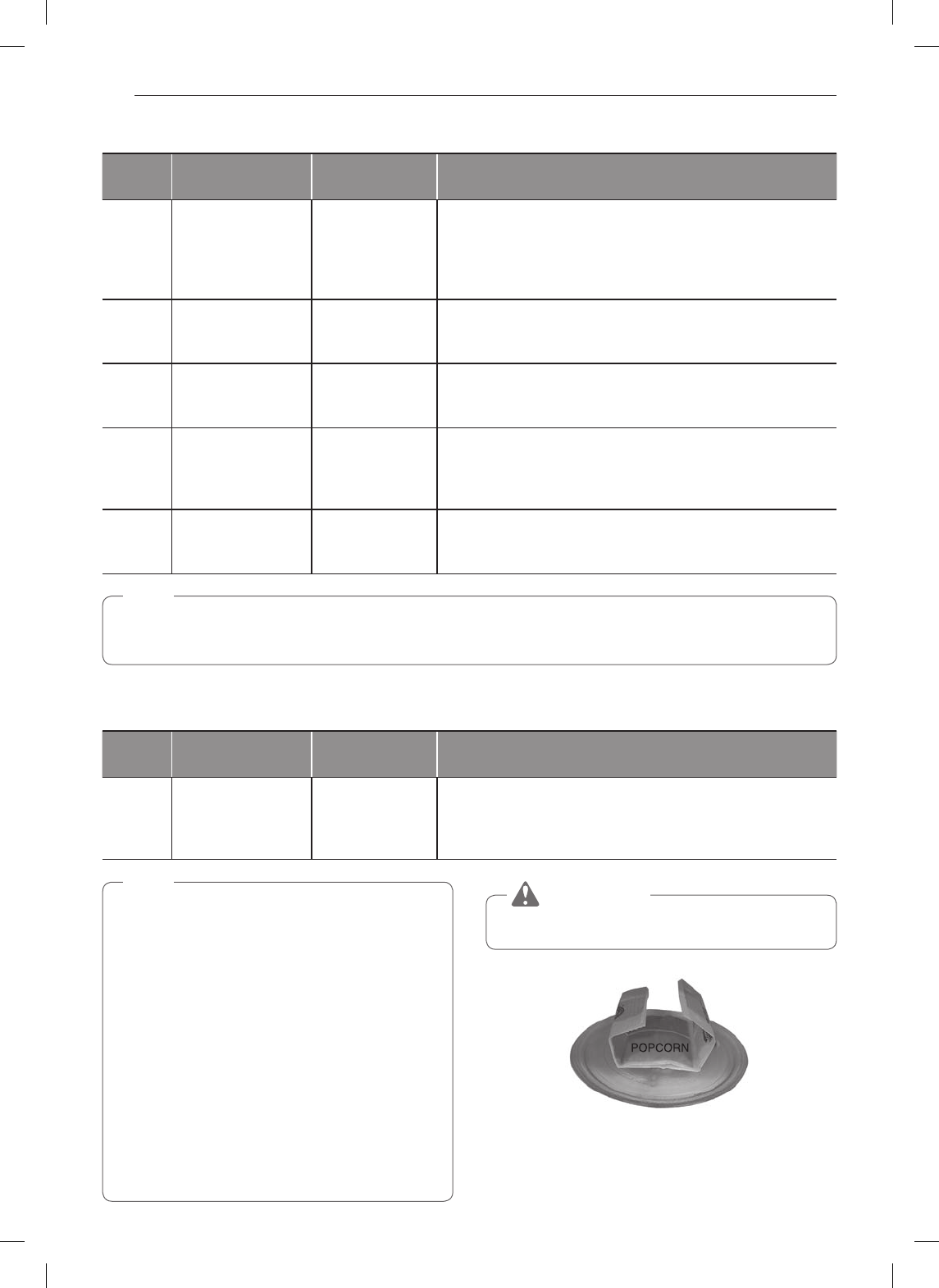
22 OPERATION
Sensor Reheat Table
Code Category Recommended
Amounts Directions
Sr-1 Beverage 1 - 2 cups
(240 ml per cup)
Use a mug or microwave-safe cup. Do not cover.
Stir after reheating.
(Be careful! The beverage will be very hot. Sometimes
liquids heated in cylindrical containers will splash out
unexpectedly when the cup is moved.)
Sr-2 Casserole 10 - 20 oz Place in a microwaveable bowl or casserole.
Cover with vented plastic wrap.
Let stand 3 minutes after heating.
Sr-3 Dinner plate 1 Place food on a plate.
Cover with vented plastic wrap.
Let stand 3 minutes after heating.
Sr-4 Pie 10 - 20 oz Cut leftover pie into pieces.
Place food on a microwave-safe dish.
Place food in the oven. Choose the menu and weight,
press Start.
Sr-5 Pizza 1 - 3 slices This is a reheat function for leftover pizza. Do not use to
cook pizza. Place on paper towel on a microwave safe
plate.
NOTE
•Do not use recycled paper products in the microwave oven.
They sometimes contain impurities that cause arcing and sparking.
Popcorn Table
Code Category Recommended
Amounts Directions
Pop Popcorn 3.5 oz. Pop only one package at a time.
For best results, use a fresh bag of popcorn.
Place a bag of prepackaged microwave popcorn on the
center of the glass tray.
NOTE
•If popcorn bag size is not known, follow
manufacturers' instructions and do not use this
feature.
•Do not use POPCORN key pad in combination
with any other feature key pads.
•Do not attempt to reheat or cook any unpopped
kernels.
•Do not reuse bag. Overcooking can result in an
oven fire.
•Prepare only one bag at a time.
•Do not use popcorn popping devices in
microwave oven with this feature.
•Do not leave microwave unattended while
cooking popcorn.
CAUTION
Never use a brown paper bag for popping corn.
When popping prepackaged popcorn, place the bag
carefully in the oven so it does not touch the walls as
it rotates. Fold the ends of the bag up and toward the
center of the bag as shown.

23
OPERATION
Defrost
The oven has 4 preset defrost cycles.
The defrost feature provides the best defrosting
method for frozen foods. The Defrost Table shows the
suggested defrost cycle for various foods.
The Defrost function conveniently chimes partway
through the defrost cycle to remind you to check, turn
over, separate, or rearrange the food for best results.
1 MEAT
2 POULTRY
3 FISH
4 BREAD
Defrosting 1.2 Lbs of Meat
1Open the oven door.
Press Clear.
2Press Defrost once.
dEF1 appears in the display.
3Press + until display shows 1.2 lbs.
4Close the oven door.
Press START.
NOTE
•The countdown appears in the display after
START is pressed. The oven chimes once,
partway through the defrost cycle.
•At the chime, open the oven door and turn the
food over. Remove any food that has thawed.
Return the still frozen items to the oven and
press START to complete the defrost cycle.
Defrost Table
Category Food to be Defrosted
MEAT
(dEF1)
0.1 - 6.0 lbs
Beef
Ground beef, round steak, stew
cubes, tenderloin steak, pot roast,
rib roast, rump roast, chuck roast,
hamburger patties
Lamb
Chops, rolled roast
Pork
Chops, hotdogs, spareribs,
country-style ribs, rolled roast,
sausage
Veal
Cutlets (1 lb, ½ inch thick)
Turn food over at beep.
After defrosting, let stand for 5 - 15
minutes.
POULTRY
(dEF2)
0.1 - 6.0 lbs
Poultry
Whole, cut-up, breast (boneless).
Rinse chicken cavity with tap
water and let stand for 60 minutes
after cooking for better results.
Cornish Hens
Whole
Turkey
Breast
Turn food over at beep.
After defrosting , let stand for 60
minutes.
FISH
(dEF3)
0.1 - 4.0 lbs
Fish
Fillets, whole steaks
Shellfish
Crab meat, lobster tails, shrimp,
scallops
Turn food over at beep.
After defrosting, let stand for 5 - 10
minutes.
BREAD
(dEF4)
0.1 - 2.0 lbs
Sliced bread, buns, baguettes, etc.
Separate slices and place between
paper towels or on flat plate.
Turn food over at beep.
After defrosting, let stand for 1 - 2
minutes.

24 OPERATION
Defrosting Tips
•When using Auto Defrost, the weight to be entered
is the net weight in pounds and tenths of pounds
(the weight of the food minus the container).
•Before starting, remove the metal twist-ties which
often come with frozen food bags, and replace
them with strings or elastic bands.
•Open containers such as cartons before they are
placed in the oven.
•Always slit or pierce plastic pouches or packaging.
•If food is foil wrapped, remove foil and place the
food in a suitable container.
•Slit the skins, if any, of frozen food such as
sausage.
•Bend plastic pouches of food to ensure even
defrosting.
•Always underestimate defrosting time. If
defrosted food is still icy in the center, return it to
the microwave oven for more defrosting.
•The length of defrosting time varies according to
how solidly the food is frozen.
•The shape of the package affects how quickly
food will defrost. Shallow packages will defrost
more quickly than a deep block.
•As food begins to defrost, separate the pieces
Separated pieces defrost more easily.
•Use small pieces of aluminum foil to shield parts
of food such as chicken wings, leg tips, fish tails,
or areas that start to get warm. Make sure the foil
does not touch the sides, top, or bottom of the
oven. The foil can damage the oven lining.
•For better results, let food stand after defrosting.
(For more information on standing time, see the
Microwave Cooking Tips section.)
•Turn over food during defrosting or standing time
Break apart and remove food as required.
Weight Conversion Table
Most food weights are given in pounds and ounces.
If using pounds, food weights must be entered
into Auto Defrost in pounds and tenths of pounds
(decimals).
Use the following table if necessary to convert food
weights to decimals.
Equivalent Weight
OUNCES
1.6
3.2
4.8
6.4
8.0
9.6
11.2
12.8
14.4
16.0
DECIMAL WEIGHT
.10
.20
.30
.40
.50 One-Half Pound
.60
.70
.80
.90
1.00 One Pound
Operating Tips
•Remove fish, shellfish, meat, and poultry from
its original wrapping paper or plastic package.
Otherwise, the wrap will hold steam and juice close
to the foods, which can cause the outer surface of
the foods to cook.
•Place foods in a shallow container or in a
microwave roasting dish to catch the drippings.
•Food should still be somewhat icy in the center
when removed from the oven.
•The length of defrosting time varies according to
how solidly the food is frozen.
•The shape of the package affects how quickly food
will defrost. Shallow packages will defrost more
quickly than a deep block.
•Depending on the shape of the food, some areas
may defrost more quickly than others.
•For best results, shape ground meat into the form
of a doughnut before freezing. When defrosting,
scrape off thawed meat when the beep sounds and
continue defrosting.

25
SMART DIAGNOSIS™
SMART DIAGNOSIS™
Using the Smart Diagnosis™
Function
Should you experience any problems with the oven,
it has the capability of transmitting data via your
telephone to the LG Customer Information Center.
1Call the LG Customer Information Center at
1-800-243-0000 (U.S.).
2When instructed to do so by the call center
agent, hold the mouthpiece of your phone over
the Smart Diagnosis™ logo on the control panel.
Max.
1"
(10 mm)
NOTE
•Do not touch any other buttons.
3Open the oven door. Press and hold the Clear
button for 8 seconds, until "5" appears in
the display. Release the button and audible
transmission tones start sounding.
4Keep the phone in place until the tone
transmission has finished. The display will count
down the time.
5Once the countdown is over and the tones have
stopped, resume your conversation with the call
center agent, who will then be able to assist you
in using the information transmitted for analysis.
NOTE
•For best results, do not move the phone while
the tones are being transmitted.
•If the call center agent is not able to get an
accurate recording of the data, you may be
asked to try again.

26 MAINTENANCE
MAINTENANCE
Caring for the Microwave
Oven
Interior
Food spatters or spilled liquids stick to oven walls and
between the seal and door surfaces. Although the
oven interior has an antibacterial coating, it is best
to wipe up spillovers with a damp cloth right away.
Crumbs and spillovers will absorb microwave energy
and lengthen cooking times and may even damage
the oven. Use a damp cloth to wipe out crumbs that
fall between the door and the frame. It is important to
keep this area clean to assure a tight seal. Remove
greasy spatters with a soapy cloth then rinse and dry.
Do not use harsh detergent or abrasive cleaners.
Anti-bacterial claim based on internal testing with
e-coli and Staphylococcus bacteria, showing coating
prevents 99.99 % of bacterial growth on the surface
of the cavity of NeoChef.
Exterior
Disconnect the plug from the power outlet before
cleaning the oven to eliminate the possibility of
electric shock. Clean the outside of your oven with
soap and water then with clean water and dry with a
soft cloth or paper towel. To prevent damage to the
operating parts inside the oven, the water should
not be allowed to seep into the ventilation openings.
To clean control panel, open the door to prevent
the oven from accidentally starting, and wipe with a
damp cloth followed immediately by a dry cloth. Press
STOP after cleaning.
If steam accumulates inside or around the outside
of the oven door, wipe the panels with a soft cloth.
Steam or condensation buildup inside the door
is normal if foods are heated for a long period on
higher power levels. This is not a malfunction. The
condensation will eventually evaporate. Try covering
the food or varying the heating levels and time to
reduce any condensation forming in the door. This
may also occur when the oven is operated under
high humidity conditions and in no way indicates a
malfunction of the unit.
The door and door seals should be kept clean. Use
only warm, soapy water, rinse then dry thoroughly.
DO NOT USE ABRASIVE MATERIALS, SUCH AS
CLEANING POWDERS OR STEEL AND PLASTIC
PADS.
Metal parts will be easier to maintain if wiped
frequently with a damp cloth.
NOTE
•Abrasive cleansers, steel wool pads, gritty
wash cloths, some paper towels, etc., can
damage the control panel and the interior and
exterior oven surfaces.
To clean the glass tray and rotating ring, wash in
mild, sudsy water.
For heavily soiled areas use a mild cleanser and
scouring sponge.
The glass tray and rotating ring are dishwasher safe.
Glass Tray
Rotating Ring
Shaft

27
TROUBLESHOOTING
TROUBLESHOOTING
Frequently Asked Questions
Operation
Why is the oven light not on during cooking?
Make sure the cooking time has been set and the
START button has been pressed.
Why does steam come out of the air exhaust
vent?
Steam is normally produced during cooking. The
microwave oven has been designed to vent this
steam.
Will the microwave oven be damaged if it operates
empty?
Yes. Never operate the oven empty or without the
glass tray.
Does microwave energy pass through the viewing
screen in the door?
No. The metal screen bounces the energy back to
the oven cavity. The holes (or ports) allow only light to
pass through. They do not let microwave energy pass
through.
Why does a tone sound when a pad on the control
panel is touched?
The tone tells you that the setting has been entered.
Can my microwave oven be damaged if food is
cooked for too long?
Like any other cooking appliance, it is possible to
overcook food to the point that the food creates
smoke and even possibly fire, and damage to the
inside of the oven. It is always best to be near the
oven while you are cooking.
I've plugged the oven in and it does not work
properly. What is wrong?
The microcomputer controlling your oven may
temporarily become scrambled and fail to function
as programmed when you plug the oven in for the
first time or when power resumes after a power
interruption. Unplug the oven from the 120 V
household outlet and then plug it back in to reset the
microcomputer.
Why do I see light reflection around the outer
case?
This light is from the oven light which is located
between the oven cavity and the outer wall of the
oven.
What are the various sounds I hear when the
microwave oven is operating?
The clicking sound is caused by a mechanical switch
turning the microwave oven’s magnetron ON and
OFF.
The heavy hum and clunk is from the change in
power the magnetron draws as it is turned ON and
OFF by a mechanical switch. The change in blower
speed is from the change in line voltage caused by
the magnetron being turned ON and OFF.
Food
Is it possible to pop popcorn in a microwave
oven?
Yes, if using one of the two methods described below:
(1) microwave-popping devices designed specifically
for microwave cooking
(2) prepackaged commercial microwave popcorn that
specifies the cook time and power output needed.
Follow exact directions given by each manufacturer
for its popcorn popping product and do not leave the
oven unattended while the corn is being popped. If
corn fails to pop after the suggested time, discontinue
cooking. Overcooking could result in an oven fire.
CAUTION
Never use a brown paper bag for popping corn or
attempt to pop leftover kernels.
Why is a standing time recommended after
microwave cooking time is over?
Standing time allows foods to continue cooking
evenly for a few minutes after the actual microwave
oven cooking cycle. The amount of standing time
depends upon the density of the foods.
Why is additional time required for cooking food
stored in the refrigerator?
As in conventional cooking, the initial temperature of
food affects total cooking time. You need more time to
cook food taken out of a refrigerator than for food at
room temperature.

28 TROUBLESHOOTING
Before Calling for Service
You can often correct operating problems yourself. If your microwave oven fails to work properly, locate the
operating problem in the list below and try the solutions listed for each problem.
If the microwave oven still does not work properly, contact the nearest LG Authorized Service Center. LG
Authorized Service Centers are fully equipped to handle your service requirements.
Symptoms Possible Causes / Solutions
Oven does not start
•Plug in power cord.
•Close oven door.
•Set cooking time.
Arcing or Sparking
•Cookware is not microwave safe. When in doubt, test cookware before use.
•Do not operate oven while empty.
Incorrect time of day
•Possible power interruption. See Clock section to reset time of day.
Unevenly Cooked
Foods
•Test cookware to make sure it is microwave safe.
•Do not cook without the glass tray.
•Turn or stir food while cooking.
•Defrost food completely before cooking.
•Use correct cook time and power level.
Overcooked Foods
•Change cook time or power level.
Undercooked Foods
•Test that cookware is microwave safe.
•Defrost food completely before cooking.
•Change cook time or power level.
•Make sure ventilation ports are not blocked.
Improper Defrosting
•Test that cookware is microwave safe.
•Change defrost time or weight.
•Turn or stir food during defrost cycle.

29
WARRANTY
WARRANTY (USA)
WARRANTY: Should your LG Microwave fail due to a defect in materials or workmanship under normal home
use, during the warranty period set forth below, LG will at its option repair or replace the product. This limited
warranty is valid only to the original retail purchaser of the product and applies only when purchased and used
within the United States including U.S. Territories. Proof of original retail purchase is required to obtain warranty
service under this limited warranty.
Warranty Period HOW SERVICE IS HANDLED
LABOR: One Year from the Date of Purchase*.
PARTS (except as listed below): One Year from the
Date of Purchase*.
MAGNETRON: Ten Years from the Date of
Purchase*.
Replacement Units and Repair Parts are warranted
for the remaining portion of the original unit's
warranty period.
* Retain your sales receipt to prove the date of
purchase. A copy of your sales receipt must be
submitted at the time warranty service is provided.
Please call 1-800-243-0000 and choose the
appropriate option. (Phones are answered 24 hours
a day, 365 days per year.) Please have the product
type (Microwave) and your ZIP code ready.
Or visit our website at: www.lg.com
THIS WARRANTY IS IN LIEU OF ANY OTHER WARRANTY, EXPRESS OR IMPLIED, INCLUDING WITHOUT
LIMITATION, ANY WARRANTY OF MERCHANTABILITY OR FITNESS FOR A PARTICULAR PURPOSE.
TO THE EXTENT ANY IMPLIED WARRANTY IS REQUIRED BY LAW, IT IS LIMITED IN DURATION TO
THE EXPRESS WARRANTY PERIOD ABOVE. SIGNATURE KITCHEN SUITE WILL NOT BE LIABLE FOR
ANY INCIDENTAL, CONSEQUENTIAL, INDIRECT, SPECIAL, OR PUNITIVE DAMAGES OF ANY NATURE,
INCLUDING WITHOUT LIMITATION, LOST REVENUES OR PROFITS, OR ANY OTHER DAMAGE WHETHER
BASED IN CONTRACT, TORT, OR OTHERWISE.
Some states do not allow the exclusion or limitation of incidental or consequential damages or limitations on how
long an implied warranty lasts, so the above exclusion or limitation may not apply to you. This warranty gives you
specific legal rights and you may also have other rights that vary from state to state.
THIS LIMITED WARRANTY DOES NOT APPLY TO:
•Service trips to deliver, pick up, or install or repair the product; instruction to the customer on operation of
Service trips to your home to deliver, pick up, and/or install the product, instruct, or replace house fuses or
correct wiring, or correction of unauthorized repairs.
•Damages or operating problems that result from misuse, abuse, operation outside environmental specifications
or contrary to the requirements of precautions in the Operating Guide, accident, vermin, fire, flood, improper
installation, acts of God, unauthorized modification or alteration, incorrect electrical current or voltage, or
commercial use, or use for other than intended purpose.
The cost of repair or replacement under these excluded circumstances shall be borne by the consumer.
For complete warranty details and customer assistance, please call or visit our website:
Call 1-800-243-0000 (24 hours a day, 365 days a year) and select the appropriate option from the menu, or visit
our website at http://www.lg.com
Write your warranty information below
Product Registration Information: _______________________________________________________________________
Model: ____________________________________________________________________________________________
Serial Number: ______________________________________________________________________________________
Date of Purchase: ___________________________________________________________________________________

30 MEMO
MEMO

31
MEMO
MEMO

LG Customer Information Center
Register your product Online!
www.lg.com
1-800-243-0000
USA
Printed in China